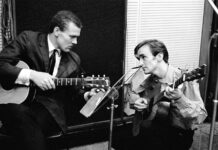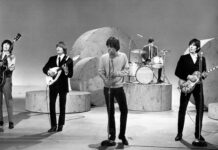
“All I wanted to do was play like Chuck Berry”: Keith Richards
This interview was originally published in 1997.
His own phrase is “five strings, two fingers, one asshole”. But everyone else has their own description of the Keith Richards phenomenon: from ‘the human riff’ through to ‘the world’s most elegantly wasted human being’. Sitting after-hours in his New York headquarters, Richards displays his own distinctive brand of fitness, born out of nervous energy rather than intensive exercise. The famous lines are etched as deeply in his face as the photographs suggest – and they match perfectly the rips in his favourite denim jacket or the dents in Micawber, his beloved Tele. Keef’s not knackered, he’s just nicely worn-in.
His new album, Main Offender, proves that Keith loves making music; whether it’s with the Stones, blues musicians like John Lee Hooker and Johnnie Johnson, or The X-Pensive Winos. “The main thing that’s struck me about this album is how lucky I am that I’ve managed to get the same bunch of guys together again, because great musicians don’t tend to hang around for three or four years. And they’re pretty hot!
“There’s not as many guest appearances as there are on the first one, but one of the things we figured from taking the Winos on the road is that you’ve got five guys there, but they all play three instruments, so you’ve got like 15 combinations. It rebounded on me, because I ended up playing bass again, something I haven’t done since Sympathy For The Devil or Let’s Spend The Night Together.”
Richards has frequently said that he’d have been a drummer if he could have coordinated all four limbs, and his partnership with Steve Jordan defines the sound of the new album, just as much as his partnership with Charlie Watts delineates the elegant chaos of the Stones. The album is bright and live, permeated by the airy snap of Jordan’s high-tuned snare drum, and on songs like Hate It When You Leave and Demon, Richards reminds us that he has a knack for classic, sensitive soul songs, as well as for vicious, simplistic guitar hooks like those of 999 or Wicked As It Seems.
Slave to the rhythm
Main Offender is miles away from the standard indulgence of a solo album. “In the Stones, if I stop playing, everything clatters to a halt. But these guys really push you. They’re confident and they know their stuff enough not to let me slouch around. So with the Stones, I’ll stop playing, go ‘I can’t remember the bridge’ and they stop, because with the Stones, there’s no point in going on. But the Winos will go: ‘Come on Keith, pick it up!’ And that’s what I needed, ’cause no-one’s gonna kick my arse in the Stones. I can fit in that bubble very comfortably, but maybe comfortable is not where it’s at. It’s one of the few times that a kick in the ass is real good!”
Richards’ ability to walk in a room, snap his fingers and work out if it will prove sympathetic to live recording is well known. So it’s no surprise that all the rhythm tracks for this album were laid down completely live: “We played in one room together. The drums were always in the same room. We put some amps in isolation booths, especially the bass amp, and usually slaved a small amp outside so we could still do it live. And we used a lot of ambient mics, so we had a lot of room sound.
Keith in a studio in 1966 with the 1962 Epiphone Casino ES-230TDV, with Tremotone unit, that he used in the mid 60s. Image: Michael Ochs Archives / Getty Images“For studios, I’m more bothered about the room than the recording hardware, because we bring in a lot of our own equipment. Basically, I look for the room itself, how high it is, what shape it is and what kind of echo it’s got. And some of the time, rooms can fool you and you think it’s gonna be easy… and the first couple of days of the session, you’re moving the drums around.
“But when you find the right setup, it’s great. So, usually, when I start, I walk in the room and say ‘Are you going to be a friend or a foe?’. “I record without headphones as much as possible – usually, the drummer has to wear them. So usually, I compromise: one ear off, one ear on. Cans are a pain – you wish you could live without them, but you can’t quite.”
Richards is a master of recording guitars, and over the years has used compressed acoustics, Nashville and other tunings, and complex overdubs which always end up sounding simple. But those big guitar sounds almost invariably come from small amplifiers: “The stuff that sounds really big always comes out of a tiny amp! So the biggest amp I used on Main Offender was a Fender Twin, then down to Champs and Silvertones.
“Steve’s one of these collectors; his apartment’s a block away from where we were doing the overdubbing, so when we need an amp, we just go and raid the crypt, rummage around. We found this little Silvertone, this tiny little amp – and it sounds massive. We tended to do a lot of overdubs on different songs, so I can’t say exactly what songs we used that one on, but on tape, it sounds fantastic. The thing with old amps, though – they’re just like people! The older they get, the more opinionated they get about whether they’re going to perform for you or not.
“I love those old amps more than my life, but they can be bitches. Try three or four Fender Champs and they’re all different – one might have this extra zing on the high end, another’s got this dirty graunch on the bottom. But that’s the beauty of them, too.”
Keith playing his 1975 Tele Custom at the Oshawa Civic Auditorium in 1979. Image: Richard E. Aaron / RedfernsThe band master on Bandmasters
“For this album, I also used a Fender Bandmaster, which is halfway between a Bassman and a guitar amp. And I use a Fender Bassman, which is almost impossible to record, but now and then, when you get it in the right spot, it’s perfect.”
When you build up a recorded track, do you start off with a picture of the finished result in your head, or do you try parts out and see how they sound? “I don’t have a final idea in my head of how it will sound. When we start recording the song, it’s got the moves, the gut, the beat, all you can do is screw it up or make it better, so you start to put stuff on top. A lot of the time, you know what the first thing it needs is, you know you have to put one guitar on top, so one thing usually leads to another. Once the song’s out of the cage, you grab its tail and say: ‘Where you gonna take me?’
“I don’t tend to think I’ve created a song, I prefer to think that they were there, I was around and I picked it up. From there, I could make it into something good. It’s like being there and capturing it and hoping it will take me somewhere interesting.”
Thief in the night
Richards has compared his songwriting to being like a human radio, where he picks up songs out of the ether. Does he ever worry they might be someone else’s? “Yeah. Especially the good ones. I think it’s not mine. There was one Stones song, even after it was out, been a hit and had been around for years, I was convinced I’d stolen it. Nobody could tell me where it came from, but I was convinced it was a total steal – it was ages before I could put it out, I was so convinced it belonged to someone else.”
Do you ever find yourself at a loss about what to write next, we ask? “Loads of times. Very rarely does a song come all at once. Half a song, snatches of an idea, but where does it go from here? You can reach an impasse. But writing with other people, more times than you think possible, he’s got a piece of music he doesn’t know what to do with, either.
“Mick and I have done that so many times we can’t believe it. And a lot of the time, the songs will be in different keys, and I’m thinking, how the hell do we fit these together, I’m gonna have to change the key, and Mick might just say, ‘Just play it’ – you just stick them together – and it works!”
Keith takes a leaf out of Eddie Van Halen’s book at Madison Square Garden in 1979. Image: Michael Putland / Getty ImagesWith Jagger and Richards established as rock music’s most enduring songwriting team, it’s easy to forget that it was manager Andrew Loog Oldham who forced the two into a room together and told them to write. “We just wanted to be a blues band – and in 1962, blues was not a way to stardom. It was aimed at giving people a kick in the teeth and waving our blues flags – then suddenly you’re a pop star. When I started, all I wanted to do was play like Chuck [Berry]. I thought if I could do that, I’d be the happiest man in the world. Then, when I found out I could do it, I thought, well maybe there is another aim in life. But when I started I’d dream of playing with Muddy Waters, but the only way I’d imagine it happening would be ‘if I make it to heaven – and he makes it there – then we can play together’.”
It wasn’t long after the release of the Stones’ first album that Richards achieved his wish; the band went to Chess Studios in June 1964 in search of better recording quality than Britain’s comparatively backward studios. “The weirdest thing was that when we met Muddy he was painting Chess studios. You walk in and start recording, on your hands and knees in this mecca, and they say you might like to meet this guy who’s up on a stepladder in a white overall and you say: ‘Who’s that?’ That’s Muddy Waters.
“It was another of those slaps around the face. He wasn’t selling records. And at the same time, he was a real gentleman. I would have expected a ‘get out of here, white trash’ reaction. But those guys were gentlemen, they saw wider than the music business. They immediately nurtured us, and had no reason to know that in a year or two they’d be selling more records than they ever had in their lives.”
Although Keith’s playing is perhaps closer to the spirit of Chuck Berry and Jimmy Reed than any of his peers, the first few years of the Stones output saw him move light-years beyond his roots. Early Jagger/Richards compositions like 19th Nervous Breakdown saw him honing the art of the simple rock riff, an art which Richards raised to its apogee with (I Can’t Get No) Satisfaction – a song which, incidentally, provoked an early Jagger/Richards argument, Richards believing his own song was a one-riff gimmick; Jagger, band and Loog Oldham convinced it was a surefire winner. “Yeah, I thought it was a Mickey Mouse song. It was one of those songs that just comes in a dream, real easy, but I thought the fuzztone was just a gimmick.”
No. 1 in Britain and the US, …Satisfaction set the seal on the writing partnership, and also confirmed the band’s movement away from the leadership of Brian Jones. Keith has commented before how Jones lost interest in the guitar, experimenting instead with the likes of the harpsichord and dulcimer. Jones’ loss of commitment – and later his death – left Richards with a void to fill that would inspire his greatest moments. A key point in this move was his discovery of open-G tuning.
“That all happened when the Stones had exhaustedly come to a halt in 1966 and I started listening to all my blues records again and reading the liner notes, and realised: ‘Right, he’s using a different tuning’. So in that period between ’66 and Beggars Banquet, I started getting into blues tunings, Fred McDowell, 12-string and slide shit. But still in D and E.”
At the same time, Richards had made friends with Gram Parsons, who provided a complete education in country music: “Gram taught me the difference between Nashville and Bakersfield – I’d loved the sound of that music, but Gram took me right into the background of it.” But although Parsons’ country feel would influence tracks like Country Honk and Love In Vain, the one-time Byrd was “strictly a standard tuning guy”.
It was Ry Cooder, who came in for the Sister Morphine sessions, who showed Richards the tuning he would make his own. “I met Ry in 1968, when he was hanging around with Taj Mahal and Jesse Ed Davis. There were people like Clarence White around, too, some good guitar players! So we’d all pick stuff up from each other. Ry was using open G for slide, I saw him and thought, that’s a really nice tuning. It restricts you so much; five strings, three notes, two fingers… one asshole!”
Image: Michael Putland / Getty ImagesHot streak
“There’s something about being restricted that opens up the possibilities. With a synthesizer, you can do anything you like. I don’t want to do anything I like! I wanna do something that ties me down, where I can manoeuvre. So I started playing in G without the slide, and started to find other chords and realise this was a really good vehicle for me. Especially ’cause Brian had just… croaked, it was a period where there was no other guitar player and I was trying to figure out what the hell to do next. Then I started to work with Mick Taylor and we really hit our stride, Beggars Banquet, Let It Bleed, Sticky Fingers, then we had to move out; Exile On Main St. we worked together all in one joint.”
Throughout the course of those albums, Richards would find his own vision, defining and refining the Stones’ sound more and more. He was experimenting with Nashville tuning (in which the four ‘bass’ strings are tuned an octave higher – which, when doubled with a standard tuning, gives a 12-string effect), as well as using acoustics, preamped and compressed by a cheap tape recorder for rhythm parts on songs like Street Fighting Man. By the time of Exile…, the Stones were recording in the damp basement of Richards’ house in the French Riviera, and the chaotic conditions produced what many regarded as the Stones’ finest work.
“Especially making Exile…, I found this thing [the guitar] can do loads of things. It was there I really started appreciating the guitar. I thought: it’s got so many possibilities, and I’m just tinkering with it. And I still am. But it was there that I realised that this wasn’t a tool that I could master, it was something that I could spend my whole life doing.”
Richards has often commented that with Mick Taylor in the band “it became more like regular rhythm and lead guitar – it was much harder to get the Stones’ sound”. But there are many stories over how he was replaced. And was Ry Cooder, who helped Keith find his own sound, ever in the running for a place in the Stones?
“Ry? Musically, yes, I would have had him in the band. Personality-wise, no way. Ry wouldn’t have fitted – and he was always his own man. I only found out lately that Eric wanted to jump in after Mick Taylor, but never did say so. But he expected us to call! It’s like: ‘Why didn’t you call me?’ – ‘Because you’re too damn good – and you’re your own man!’. There’s certain guys that are band players and there’s certain guys that ain’t. That’s not a reflection on anybody. Eric’s a great leader, but he’s not a good bandleader. Eric’s a chameleon – I love him dearly and he knows that… he’s changed his hair again. And those suits! But if there’s anybody lazier than me, it’s Eric. He’s got it all, but Eric’s like Mick Taylor in a way, he needs to hire guys to play with him to kick him up the arse.
“The best playing I’ve heard from Eric in over 10 years was that thing with Chuck Berry, Wee Wee Hours, when he had a band kicking him up the arse, and he had to come through. And when he has to come through, Eric will come through like dynamite, but a lot of the time, he’s cruising. You can be good, but you’re not gonna be good with a bunch of Yes Men. They might be fantastic musicians, but he’s avoiding guys who say ‘Eric, you’re wrong’. You need a team.”
Keith on the Pyramid Stage at the 2013 Glastonbury Festival. Image: Ian Gavan / Getty ImagesPutting the band back together
Richards’ obsession with keeping his team together has also caused its frustrations. “The 70s were a hard time. Especially when they kicked us out of London, it’s very hard to keep a tight unit together once you’ve been displaced from your own turf. So our main battle then was to keep the band together and write songs when you’re several thousand miles apart, rather than ‘I’ve written a song, I’ll be round in five minutes’. But then you realise that this is all a challenge… Nobody’s taken music this far – and it’s a voyage of discovery.
“I’m looking forward more because now we’ve got over that stopping and starting thing. There’s no way the Stones would have made Steel Wheels, starting it in February and ending it in June, if we hadn’t done separate stuff. You would’ve spent two months getting the band into shape. For musicians, it’s practice. You can’t take two years off. So early in the New Year, Mick and I will get together and see what we’ve got. Bill’s another subject, though.”
Doubts about whether Wyman will return to the Stones camp after the current hiatus in the band’s activity have been circulating for some time now. At one point, it was even rumoured Jagger’s solo sidekick, Doug Wimbish, would be stepping in. Richards doesn’t want to see any change.
“Bill, I’ve got to see eyeball to eyeball to get this thing sorted out once and for all. I don’t want to say too much. My basic attitude is the Stones are getting together and I expect him to be there, I don’t want to see this line-up change now. My basic attitude is the Stones are getting together and I expect him to be there, but at the same time I know I can’t leave it that long. I don’t wanna hear any more rumours and bullshit. It won’t stop the Stones going on. I don’t know what we’d do. Maybe he’s happy running his restaurants… I don’t know.
“Bill’s a very noncommital guy, which is why I can’t talk to him on the phone. Charlie says maybe we could threaten to replace him with a chick – maybe that will do the trick! It’s a drag when your family squabbles are in the papers and everything you do is a potential headline. My view of life is totally distorted.”
Wild horses
But whatever happens, Keith will find a way of keeping his band going. And whatever mistakes they might make along the way – well, that’s all part of the grand design.
“It could fall apart. It’s a balancing act. But you can fall down and get up. I guess I got over my embarrassment over falling down in public a long time ago. That, to me, is what makes it interesting. You set yourself up for a fall, you don’t wanna fall but you know you can get up.
“I really feel for new bands that are coming up because these days, you need a quarter of a million dollars before you can start. And with that big money, the marketing men want to play it safe. And when you play safe, the best you’re gonna come up with is something that’s not bad. And we’re not here talking because music is not bad. We’re here because it’s fucking great! Playing safe is not what it’s about. This music is all about beautiful fuck-ups. And beautiful recoveries.”
Read our 2019 interview with Ronnie Wood here.
The post “All I wanted to do was play like Chuck Berry”: Keith Richards appeared first on Guitar.com | All Things Guitar.
Source: www.guitar-bass.net













